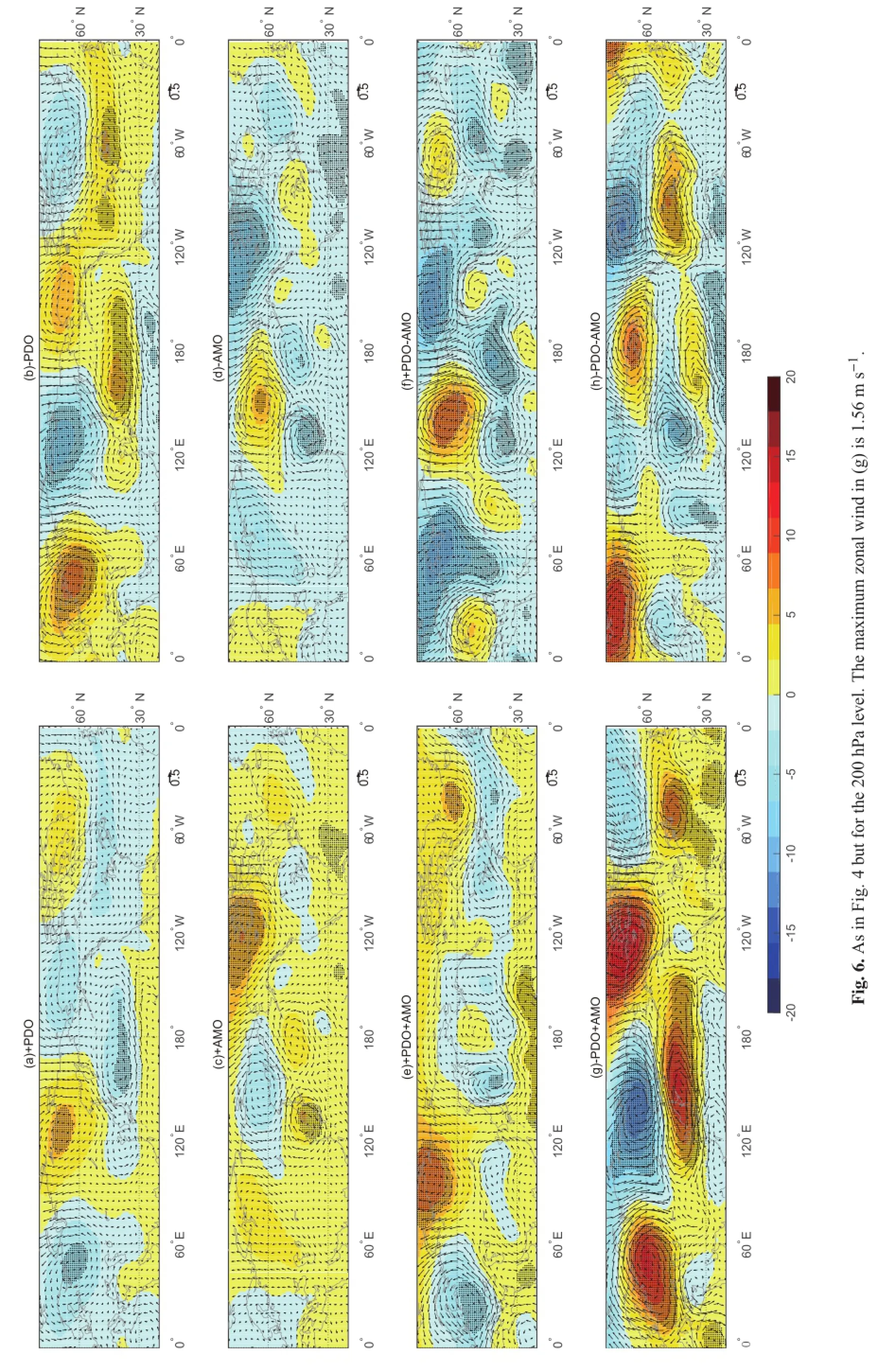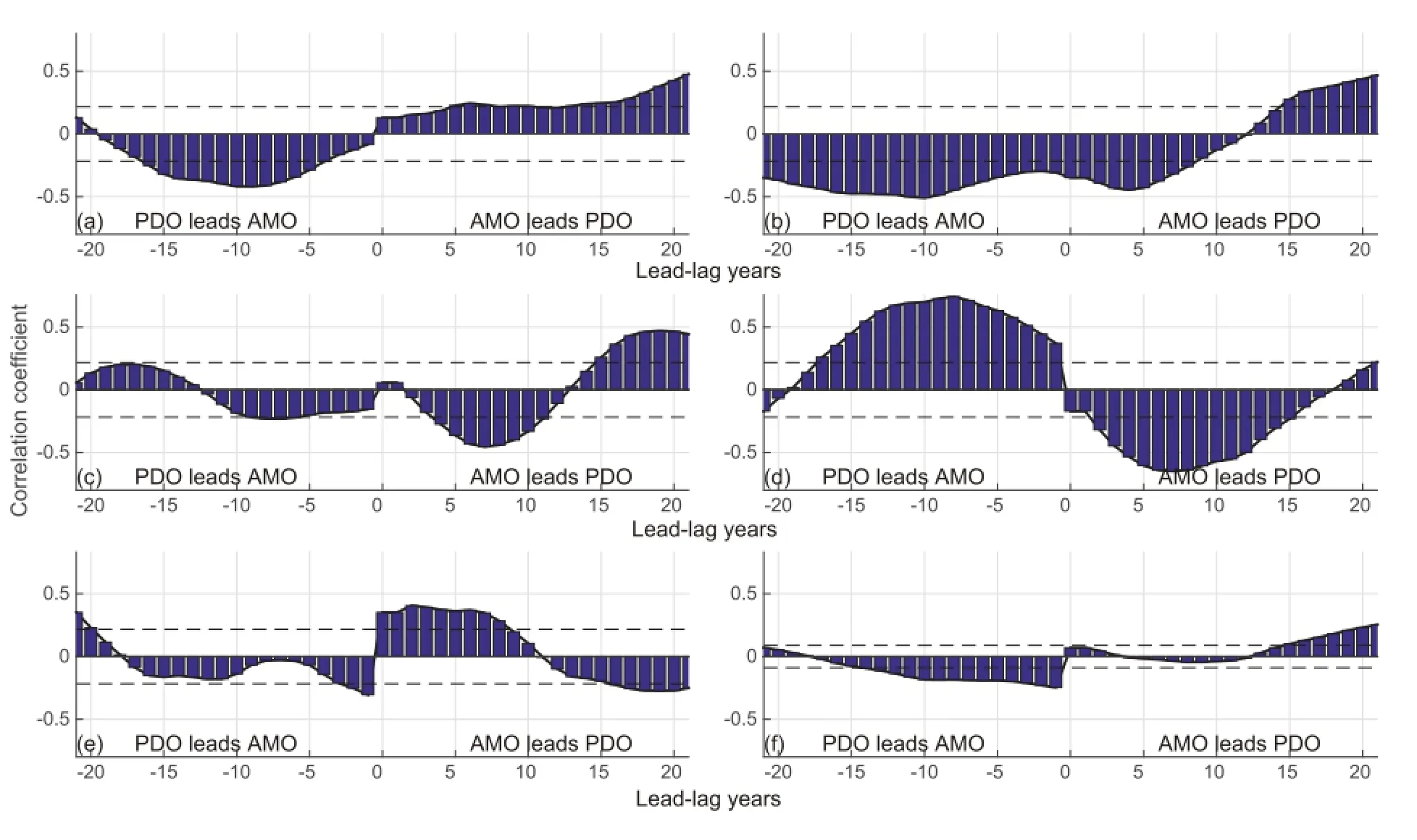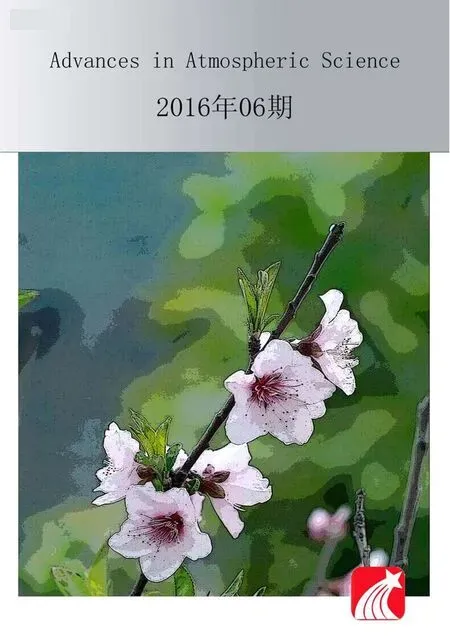Influence of Internal Decadal Variability on the Summer Rainfall in Eastern China as Simulated by CCSM4
Yali ZHU*1,2,Tao WANG1,2,and Jiehua MA2
1Nansen-Zhu International Research Centre,Chinese Academy of Sciences,Beijing 100029
2Climate Change Research Centre,Chinese Academy of Sciences,Beijing 100029
Influence of Internal Decadal Variability on the Summer Rainfall in Eastern China as Simulated by CCSM4
Yali ZHU*1,2,Tao WANG1,2,and Jiehua MA2
1Nansen-Zhu International Research Centre,Chinese Academy of Sciences,Beijing 100029
2Climate Change Research Centre,Chinese Academy of Sciences,Beijing 100029
The combined impact of the Pacific Decadal Oscillation(PDO)and Atlantic Multidecadal Oscillation(AMO)on the summer rainfall in eastern China was investigated using CCSM4.The strongest signals occur with the combination of a positive PDO and a negative AMO(+PDO-AMO),as well as a negative PDO and a positive AMO(-PDO+AMO).For the+PDO-AMO set,significant positive rainfall anomalies occur over the lower reaches of the Yangtze River valley(YR), when the East Asian summer monsoon becomes weaker,while the East Asian westerly jet stream becomes stronger,and ascending motion over the YR becomes enhanced due to the jet-related secondary circulation.Contrary anomalies occur over East Asia for the-PDO+AMO set.The influence of these two combinations of PDO and AMO on the summer rainfall in eastern China can also be observed in the two interdecadal rainfall changes in eastern China in the late 1970s and late 1990s.
Pacific Decadal Oscillation,Atlantic Multidecadal Oscillation,eastern China,summer rainfall,CCSM4
1.Introduction
Recent studies on the global warming hiatus since the beginning of the 21st century note the important contribution of internal decadal variability on global climate changes (Kosaka and Xie,2013;Meehl et al.,2013;Trenberth and Fasullo,2013;Dai et al.,2015).The Pacific Decadal Oscillation(PDO)(e.g.,Trenberth and Hurrell,1994;Mantua et al.,1997)and Atlantic Multidecadal Oscillation(AMO) (e.g.,Enfield et al.,2001)are the two dominant modes at the decadal timescale.These oscillations can exert significant influences on regional climate in Europe,Asia,and North America(e.g.,Barlow et al.,2001;Yeh and Kirtman,2004; Knight et al.,2006;Zhang and Delworth,2006;Ma,2007; Sun et al.,2008;Chylek et al.,2014;Qian and Zhou,2014).
Interdecadalclimate change is an important feature of the East Asian climate.Two prominent interdecadal changes occurred in the eastern China summer rainfall in the late 1970s (Wang,2001;Ding et al.,2008;Wang et al.,2013)and the late 1990s(Zhu et al.,2011,2015;Si and Ding,2013).After the late 1970s,summer rainfall over the lower reaches of the Yangtze River valley(YR)increased significantly,while it decreased over North China.After the late 1990s,summer rainfall decreased in the lower reaches of the YR,while itincreased in the Huanghe River-Huaihe River valleys.Previous studies proposed either the PDO or AMO as the major modulator for these two interdecadal changes in the eastern China summer climate(e.g.,Zhu and Yang,2003;Ma,2007; Xu and Zhu,2010;Zhu et al.,2011;Li and Luo,2013;Qian and Zhou,2014;Hao et al.,2015;Yu et al.,2015;Zhu et al., 2015).
However,thePDO andAMO arenot isolated;rather,they interact with each other(Wu et al.,2011).Our decadal-scale climate is not only modulated by either the PDO or AMO, but also by a combination of them,with distinct phase combinations in different periods.In the present study,we used a control multi-century simulation from CCSM4 to investigate the modulation impacts of the PDO and AMO on the summer rainfall and its associated circulation in eastern China from intrinsic variability only.The complex external forcing agents were not considered.In section 2,the model and numerical experiment are introduced.Section 3 summarizes the results,and section 4 concludes the findings and presents further discussion.
2.Model and numerical experiment
TheoutputdataofthecontrolsimulationbyCCSM4were analyzed in this study.CCSM4 is a global coupled climate model with a 1°,26-level atmosphere coupled to a 1°(down to 1/48 in the equatorial tropics),60-level ocean and state-of-the-art sea-ice and land surface schemes(Gent et al.,2011). The 501-year control simulation was conducted with no interannual variations in the external forcing agents and with greenhouse gases and the tropospheric sulfate aerosol concentration fixed at pre-industrial(1850)levels.Therefore, only the internal variability of the climate system was manifested and no long-term trend existed in this simulation.
©Institute of Atmospheric Physics/Chinese Academy of Sciences,and Science Press and Springer-Verlag Berlin Heidelberg 2016
The atmospheric variables used included precipitation, geopotential height,and wind field.The SST was used to calculate the PDO and AMO indices.The PDO index was defined as the leading principal component of annual SST anomalies in the North Pacific(20°–60°N,110°E–110°W). The AMO index was defined as the average annual SST in the North Atlantic(0°–60°N,75°–7.5°W).The 11-point running mean was used on the indices to highlight their decadal signals.The observed AMO and PDO indices were obtained from http://www.esrl.noaa.gov/psd/data/timeseries/ AMO/and http://research.jisao.washington.edu/pdo/,respectively.
3.Results
The simulated PDO and AMO indices are shown in Fig. 1.To identify the connections between the PDO/AMO and summer rainfall in eastern China,we first divided the 501 model years into eight different sets:+PDO(i.e.,PDO index>0);-PDO(i.e.,PDO index<0);+AMO(i.e.,AMO index>0);-AMO(i.e.,AMO index<0);+PDO+AMO; +PDO-AMO;-PDO+AMO;and-PDO-AMO.There were 297,204,273,228,169,128,104,and 100 model years for the eight sets,respectively.The composite analysis was conducted by subtracting the long-term mean of the whole period from the average of each set.
The+PDO(Fig.2a)and-PDO(Fig.2b)caninducemore and less rainfall over the lower reaches of the Yangtze River–HuaiheRiver valleys(centeredoverthe Huaihe River valley), respectively,though the+PDO signals are not statistically significant.Incontrast,the+AMO(Fig.2c)and-AMO(Fig. 2d)are related to decreased and increased rainfall centered over the lower reaches of the YR.It seems that the-AMO (Fig.2d)can induce significantly increased Mei-yu rainfall over eastern Asia.The anomalies are weak and insignificant in eastern China in the+PDO+AMO set(Fig.2e).However, significant increased rainfall is evident over the western subtropical Pacific,which is a mutual reinforcing effect between the+PDO(Fig.2a)and+AMO(Fig.2c).Differently,in the +PDO-AMO set,these two decadal signals reinforce each otherovereasternChina(Figs.2a,dandf),leadingtopositive rainfall anomalies over the lower reaches of the YR,centered near(30°N,120°E).The-PDO and+AMO can strengthen each other and induce a band of significant negative rainfall anomalies covering the YR and southern Japan(Figs. 2b,c and g).The-PDO and-AMO reinforce each other in thePacificOcean,withanegative–positive–negative–positive pattern from the western tropical to subtropical Pacific(not shown).However,their effects counteract each other and no significant signals occur over eastern China(Figs.2b,d and h).
The connection between the combined PDO and AMO and summer rainfall in eastern China can be observed in the two recent interdecadal changes in the late 1970s and the late 1990s.Accompanying+PDO-AMO(Fig.3),summer rainfall increases over the YR and decreases over North China after the late 1970s(e.g.,Wang,2001;Ding et al.,2008; Wang et al.,2013),while summer rainfall decreases over the YR and increases over the Huanghe River–Huaihe River valleys when accompanying+PDO-AMO after the late 1990s (e.g.,Zhu et al.,2011;Si and Ding,2013;Zhu et al.,2015). This observed consistency between the interdecadal changes ofsummerprecipitationandthe phasesof thePDO andAMO are consistent with the model results.
The+PDO corresponds to decreased SLP centered over East Asia and the adjacent ocean(Fig.4a),while the-PDO corresponds to positive SLP anomalies there(Fig.4b).In contrast,the+AMO is relatedto positiveSLP anomaliesover East Asia and oppositeanomalies overthe ocean to the south, showing a strengthened zonal land–sea thermal contrast(Fig. 4c),while the-AMO is related to negative SLP anomalies over East Asia and opposite anomalies over the ocean to the south,showing a weakened zonal land–sea thermal contrast (Fig.4d).However,the impact of a single PDO or AMO on SLP inEastAsiais weak.The-PDO+AMOsetis connected with strong positive SLP centered over East Asia,and thus the land–sea thermal contrast there is significantly strengthened(Fig.4g).In the other three sets,the land–sea thermal contrast becomes somewhat reduced,though the signals are relatively weak.
In the lower-level wind and geopotential height field,the effect of the PDO and AMO in their opposite phases can enhanceeachotherovereasternChina(Fig.5),asinthesummer rainfall field.For example,boththe-PDO and+AMO(Figs. 5b and c)are related to positive height anomalies over East Asia and negative height anomalies over the Okhotsk Sea, which resembles an East Asia–Pacific(EAP)teleconnection pattern.This combinationof-PDO+AMO exhibits stronger significant anomalies over East Asia and the Okhotsk Sea (Fig.5g).Southerly anomalies occur over eastern China north of 30°N,showing a strengthened East Asian summer monsoon.Compared with Fig.5g,opposite changes occur in the+PDO-AMO composite(Fig.5f),but the amplitude and area with significant values are smaller.The anomalies in the monsoon circulation are consistent with the SLP anomalies reflecting the land–sea thermal contrast.

Fig.1.The PDO and AMO indices in the 501-year control experiment.

Fig.2.The composite summer precipitation rate(units:kg m-2s-1)between different sets of the PDO and AMO combinations and the entire period.Dotted areas show the significant difference at the 90%confidence level.

Fig.3.The standardized observed AMO(red)and PDO(blue)indices during 1948–2014.

Fig.5.As in Fig.4 but for the 850 hPa wind field(vectors)and geopotential height(color shading).The maximum zonal wind in(g)is 0.65 m s-1.Dotted areas show the significant geopotential height difference at the 90%confidence level.The missing values are shown in white.
In addition,we also studied the upper-level circulation over a larger area to examine the related large-scale features. The anomalies are stronger and better organized than those in the lower level.The PDO can induce significant anomalies over the subtropical North Pacific,close to the Kuroshio extension region(Figs.6a and b).Significant anomalies also appear over western and eastern Eurasia,forming a wavetrain pattern in the northern high latitudes.The most prominent anomalies induced by the AMO locate over the high latitudes of North America(Figs.6c and d).Besides,significant anomalies also occur over East Asia in a small area.The effect of the+PDO and+AMO can reinforce each other in the low latitudes and northwestern Eurasia,but counteract each other over East Asia(Fig.6e).The-PDO+AMO set is related to the wave-train pattern in the northern high latitudes (Fig.6g),as well as significant cyclonic anomalies over East Asia and the North Pacific.The-PDO+AMO combination also has the strongest anomalies(Fig.6g).Significant positive geopotential height anomalies occur over Europe and NorthAmerica,implyingthepresencethereofsignificantclimate anomalies.These significant large-scale anomalies imply that the PDO and AMO can not only influence the summer rainfall in eastern China,but also have an impact on climate in other regions,such as India and West Africa(Li et al.,2012).The strong anticyclonic anomalies over East Asia, which are associated with the EAP-like pattern,can induce significant easterly anomalies related to the southern branch of these anticyclonic anomalies.Therefore,the East Asian westerly jet stream(EAWJS)is weakened and moves northward.
Moreover,the weakened EAWJS is related to the decreased rainfall over the YR(Fig.2g)by suppressing the jet-related secondary circulation(Ding,2008).A weakened EAWJS is connected to a weaker jet-related secondary circulation,and the ascending branch centered over the YR is reduced,thereby decreasing the rainfall.Figure 7 shows the vertical velocity:robust signals occur in the+PDOAMO(Fig.7f)and-PDO+AMO(Fig.7g)sets.Both the -PDO and+AMO can induce somewhat descending anomalies over the YR(Figs.7b and c).However,their combination is related to much stronger descending anomalies over the YR than their individual counterparts(Fig.7g).Therefore,the rainfall over the YR is decreased.Conversely,forthe+PDO-AMO set,significant ascending anomalies occur over the YR(Fig.7f),and the rainfall there increases.


Fig.7.As in Fig.4 but for the latitude-geopotential height cross-section of mean vertical velocity over 110°–120°E. Shading shows the significant difference in vertical velocity at the 90%confidence level.The contour interval is 10-3Pa s-1.Red(blue)contours represent descending(ascending)anomalies.Black contours show the contours of zero.
4.Conclusion and discussion
Using the pre-industrial control simulation of CCSM4, weanalyzedtheimpactofdifferentcombinationsofPDO and AMOphasesonsummerrainfallineasternChina.Theresults indicatedthatcombinationsofthePDOandAMOinopposite phases have the most robust impact on eastern China summerrainfallandrelatedcirculations:-PDO+AMO(+PDOAMO)is related with decreased(increased)rainfall over the YR;the land–sea thermal contrast is somewhat stronger;the East Asian summermonsoonis strengthened(weakened);the EAWJS is weaker(stronger);and ascending motion related with the EAWJS over YR is inhibited(enhanced).In our recent decadal climate changes,the situation was consistent with that simulated in CCSM4:+PDO-AMO corresponded to more rainfall over the YR from the late 1970s to the late 1990s,while-PDO+AMOcorrespondedtoless rainfallover the YR after the late 1990s.However,the decreased rainfall in North China after the late 1970s,as well as the in-creased rainfall in the lower reaches of the Huanghe River-Huaihe River valleys after the late 1990s,were not presented in CCSM4.One of the possible causes may be the model’s insufficiency in simulating the East Asian climate,which is a common disadvantage for state-of-the-art climate models. Another may be that the impact of anthropogenic forcing,to which the interdecadal changes in East Asian summer rainfall could be partly attributed,is not represented in the preindustrial simulation of CCSM used in this study.

Fig.8.The running correlation coefficient between the PDO and AMO in the first,second,third,fourth and fifth 100 years (a–e)and the whole period of the control simulation.Dashed lines denote the values at the 95%confidence level.
Although combinations of the PDO and AMO are good indicators for summer rainfall variation in eastern China at the decadal time scale,correlations between them were inconsistent in CCSM4.For the 501-year time series used in this study,their relationship varied(Fig.8):sometimes positive,sometimes negative,sometimes PDO leading the AMO, and sometimes the other way round.Although Wu et al. (2011)revealed that,based on observational data for the period 1870–2002,significant correlations show up when the PDO leads the AMO by 1 year and when the AMO leads the PDO by11–12years,whenbasedonourlongermodeloutput dataset the correlations are probably unstable.In addition,to predict either the PDO or AMO is difficult for numerical and statistical models at present.Therefore,to predict the combinations of the PDO and AMO and decadal changes of summer rainfall in eastern China are more challenging issues.
Acknowledgements.We want to thank Dr.Dong GUO and Jun WANG for their help with the figures.This work was jointly supported by the National Natural Science Foundation of China (Grant Nos.41205054,41205051 and 41210007),and the CASPKU Pioneer Cooperation Program.
REFERENCES
Barlow,M.,S.Nigam,and E.H.Berbery,2001:ENSO,Pacific decadal variability,and U.S.summertime precipitation, drought,and stream flow.J.Climate,14(9),2105–2128.
Chylek,P.,M.K.Dubey,G.Lesins,J.N.Li,and N.Hengartner, 2014:Imprint of the Atlantic multi-decadal oscillation and Pacific decadal oscillation on southwestern US climate:Past, present,and future.Climate Dyn.,43(1–2),119–129.
Dai,A.G.,J.C.Fyfe,S.P.Xie,and X.G.Dai,2015:Decadal modulation of global surface temperature by internal climate variability.Nature ClimateChange,5,555–559,doi:10.1038/ nclimate2605.
Ding,Y.H.,2008:Upper tropospheric jet stream and the related secondary circulation.Advanced Synoptic Meteorology,Y.H. Ding,Ed.,China Meteorological Press,138–149.
Ding,Y.H.,Z.Y.Wang,and Y.Sun,2008:Inter-decadal variation of the summer precipitation in East China and its association with decreasing Asian summer monsoon.Part I:Observed evidences.Int.J.Climatol.,28(9),1139–1161.
Enfield,D.B.,A.M.Mestas-Nuñez,and P.J.Trimble,2001:The Atlantic multidecadal oscillation and its relation to rainfall and river flows in the continental U.S.Geophys.Res.Lett., 28(10),2077–2080.
Gent,P.R.,and Coauthors,2011:The community climate system model version 4.J.Climate,24,4973–4991.
Hao,X.,F.Li,J.Q.Sun,H.J.Wang,and S.P.He,2015:Assessment of the response of the East Asian winter monsoon to ENSO-like SSTAs in three U.S.CLIVAR Project models.Int. J.Climatol.,doi:10.1002/joc.4388.
Knight,J.R.,C.K.Folland,and A.A.Scaife,2006:Climate impacts of the Atlantic Multidecadal Oscillation.Geophys.Res. Lett.,33(17),L17706.
Kosaka,Y.,and S.-P.Xie,2013:Recent global-warming hiatustied to equatorial Pacific surface cooling.Nature,501,403–407,doi:10.1038/nature12534.
Li,H.L.,H.J.Wang,and Y.Z.Yin,2012:Interdecadal variation of the West African summer monsoon during 1979–2010 and associated variability.Climate Dyn.,39(12),2883–2894.
Li,S.L.,and F.-F.Luo,2013:Lead-Lag connection of the Atlantic Multidecadal Oscillation(AMO)with East Asian surface air temperatures in instrumental records.Atmos.Oceanic Sci.Lett.,6(3),138–143.
Ma,Z.G.,2007:The interdecadal trend and shift of dry/wet over the central part of North China and their relationship to the PacificDecadal Oscillation(PDO).Chinese Sci.Bull.,52(15), 2130–2139.
Mantua,N.J.,S.R.Hare,Y.Zhang,J.M.Wallace,and R.C.Francis,1997:A Pacific interdecadal climate oscillation with impacts on salmon production.Bull.Amer.Meteor.Soc.,78(6), 1069–1079.
Meehl,G.A.,A.X.Hu,J.M.Arblaster,J.Fasullo,and K. E.Trenberth,2013:Externally forced and internally generated decadal climate variability associated with the interdecadal Pacific oscillation.J.Climate,26(18),7298–7310, doi:10.1175/JCLI-D-12-00548.1
Qian,C.,and T.J.Zhou,2014:Multidecadal variability of North China aridity and its relationship to PDO during 1900–2010. J.Climate,27(3),1210–1222.
Si,D.,and Y.H.Ding,2013:Decadal change in the correlation pattern between the Tibetan Plateau winter snow and the East Asian summer precipitation during 1979–2011.J.Climate, 26(19),7622–7634.
Sun,J.Q.,H.J.Wang,W.Yuan,2008:Decadal variations of the relationship between the summer North Atlantic Oscillation and middle East Asian air temperature.J.Geophys.Res.,113, D15107.
Trenberth,K.E.,and J.T.Fasullo,2013:An apparent hiatus in global warming?Earth’s Future,1(1),19–32,doi:10.1002/ 2013EF000165.
Trenberth,K.E.,and J.W.Hurrell,1994:Decadal atmosphereocean variations in the Pacific.Climate Dyn.,9(6),303–319.
Wang,H.J.,2001:The weakening of the Asian monsoon circulation after the end of 1970’s.Adv.Atmos.Sci.,18(3),376–386, doi:10.1007/BF02919316.
Wang,T.,H.J.Wang,O.H.Otterå,Y.Q.Gao,L.L.Suo,T.Furevik,and L.Yu,2013:Anthropogenic agent implicated as a prime driver of shift in precipitation in eastern China in the late 1970s.Atmos.Chem.Phys.,13(5),11997–12032.
Wu,S.,Z.Y.Liu,R.Zhang,and T.L.Delworth,2011:On the observed relationship between the Pacific Decadal Oscillation and the Atlantic Multi-decadal Oscillation.Journal of Oceanography,67(1),27–35.
Xu,K.,and C.W.Zhu,2010:Tropical Pacific decadal oscillation in subsurface ocean temperature.Atmos.Oceanic Sci.Lett., 3(2),106–110.
Yeh,S.,and B.Kirtman,2004:Decadal North Pacific sea surface temperature variability and the associated global climate anomalies in a coupled general circulation model.J.Geophys. Res.,109(D20),D20113.
Yu,L.,T.Furevik,O.H.Otterå,and Y.Q.Gao,2015:Modulation of thePacificDecadal Oscillation on the summer precipitation over East China:A comparison of observations to 600-years control run of Bergen Climate Model.Climate Dyn.,44(1–2), 475–494.
Zhang,R.,and T.L.Delworth,2006:Impact of Atlantic multidecadal oscillations on India/Sahel rainfall and Atlantic hurricanes.Geophys.Res.Lett.,33(17),L17712.
Zhu,Y.L.,H.J.Wang,W.Zhou,and J.H.Ma,2011:Recent changes in the summer precipitation pattern in East China and the background circulation.Climate Dyn.,36(7–8),1463–1473.
Zhu,Y.L.,H.J.Wang,J.H.Ma,T.Wang,and J.Q.Sun,2015: Contribution of the phase transition of Pacific decadal oscillation to the late 1990s’shift in East China summer rainfall.J.Geophys.Res.,120(17),8817–8827,doi:10.1002/ 2015JD023545.
Zhu,Y.M.,and X.Q.Yang,2003:Relationships between Pacific Decadal Oscillation(PDO)and climate variabilities in China. Acta Meteorologica Sinica,61(6),641–654.(in Chinese)
Zhu,Y.L.,T.Wang,and J.H.Ma,2016:Influence of internal decadal variability on the summer rainfall in eastern China as simulated by CCSM4.Adv.Atmos.Sci.,33(6),706–714,
10.1007/s00376-016-5269-x.
17 December 2015;revised 1 January 2016;accepted 7 January 2016)
Yali ZHU
Email:zhuyl@mail.iap.ac.cn
 Advances in Atmospheric Sciences2016年6期
Advances in Atmospheric Sciences2016年6期
- Advances in Atmospheric Sciences的其它文章
- Estimation and Correction of Model Bias in the NASA/GMAO GEOS5 Data Assimilation System:Sequential Implementation
- Comparison of Constant and Time-variant Optimal Forcing Approaches in El Niño Simulations by Using the Zebiak–Cane Model
- Simple Metrics for Representing East Asian Winter Monsoon Variability: Urals Blocking and Western Pacific Teleconnection Patterns
- A Double-Index Method to Classify Kuroshio Intrusion Paths in the Luzon Strait
- Impact of Spectral Nudging on the Downscaling of Tropical Cyclones in Regional Climate Simulations
- On the Relationship between the Winter Eurasian Teleconnection Pattern and the Following Summer Precipitation over China
